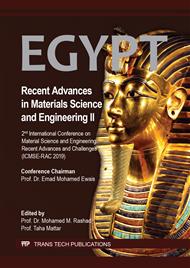[1]
M. Nete, Separation and Purification of Niobium and Tantalum from Synthetic and Natural Compounds, PhD thesis. University of the Free State, Bloemfontein, (2009).
Google Scholar
[2]
D.B. Qiou, Theory of tantalum–niobium ore dressing and its practice, World Nonferr Met. 11 (2001) 27.
Google Scholar
[3]
Z. Cheng, X.Q. Wu, P.W. Yang. The characteristics of Ta-Nb resources and its beneficiation technology. Met Min. 445 (2013) 97.
Google Scholar
[4]
Report of the Egyptian mineral resources authority, Investment chance in Egyptian mining sector, (2007).
Google Scholar
[5]
M. Nete, F. Koko, T. Theron, W. Purcell, J. T. Nel. Primary beneficiation of tantalite using magnetic separation and acid leaching, Int. J. Miner. Metall. Mater., Vol. 21, No. 12, Dec. (2014).
DOI: 10.1007/s12613-014-1022-6
Google Scholar
[6]
Y. Ghorbani, R. Fitzpatrick, M. Kinchington, G. Rollinson, P. Hegarty, A Process Mineralogy Approach to Gravity Concentration of Tantalum Bearing Minerals, Minerals. 7 (2017) 194.
DOI: 10.3390/min7100194
Google Scholar
[7]
Z.-T. Yuan, J.-W. Lu, H.-F. Wu, J.-T. Liu, Mineralogical characterization and comprehensive utilization of micro-fine tantalum–niobium ores from Songzi, Rare Metals, (2015).
DOI: 10.1007/s12598-014-0428-7
Google Scholar
[8]
O.M., El-Hussaini, M.A., Mahdy, Sulfuric acid leaching of Kab Amiri niobium–tantalum bearing minerals, Central Eastern Desert, Egypt. Hydrometallurgy. 64 (2002) 219–229.
DOI: 10.1016/s0304-386x(02)00045-2
Google Scholar
[9]
R.P.S. Gaur, R.G. Mendenhall, Inventors; Osram Sylvania Inc., assignee. Tantalum concentrates dissolution and purification method. United States Patent US 7182925 B2. (2007).
Google Scholar
[10]
El-Sayed R.E. Hassan, F. Mutelet, Use of ionic liquids for the treatment of biomass materials and biofuel production, Carbohydrate, Prof. Mahmut Caliskan (Ed.), InTech,.
DOI: 10.5772/67026
Google Scholar
[11]
N.R. Das, P. Chattopadhyay, Separation of niobium and tantalum, Journal of Radoanalytieal and Nuclear Chemistry. 109 (1987) 45-54.
Google Scholar
[12]
El-Sayed R.E. Hassan, N.A. Abdel-Khalek, M.A. Youssef, M.M. Abdallah, A.H. El-Menshawy, Recovery of albite and mica from Egyptian Abu Dabbab ores using gravity and magnetic separation techniques, Australian Journal of Basic and Applied Sciences, 11 (2017) 115-123.
Google Scholar
[13]
M.A. Youssef, M.K. Abd El-rahman, N.H. Helal, M.M. El- Rabiei, S.R. Elsaidy, Optimization of shaking table and dry magnetic separation on recovery of Egyptian placer cassiterite using experimental design technique, The Journal of Ore Dressing. 11 (2009) 1-9.
Google Scholar


